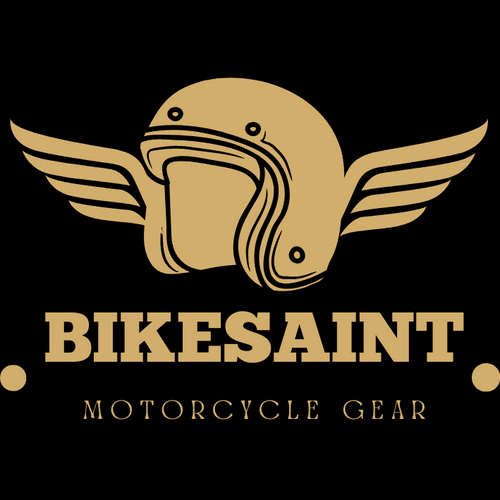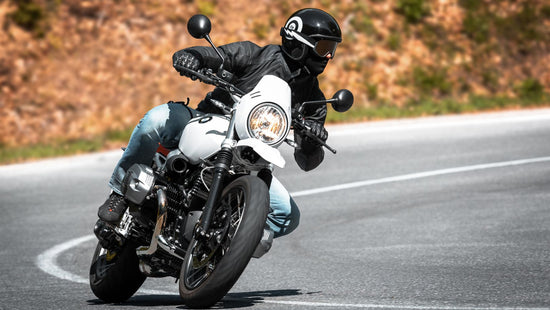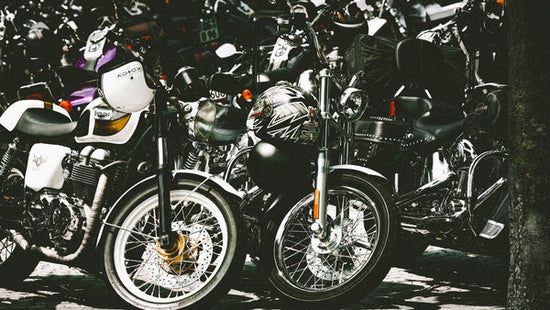

As motorcycle riders, we all know the feeling of freedom and adventure that comes with hitting the open road. But with that freedom comes a certain level of risk. As responsible riders, it's important that we take the necessary precautions to protect ourselves. This includes wearing the right protective motorcycle gear. In this article, we'll go over the basics of motorcycle protective gear and why it's so important for your safety. Whether you're a beginner biker or a seasoned rider, read on to learn more about how to gear up for a safer ride.
Introduction
Do you also ride your motorcycle in your skinny jeans and Adidas tennis shoes? Maybe you are a beginner rider who did not get the proper information in your motorcycle school or it didn’t sink in. Maybe you do not have enough riding buddies to tell you their stories about motorcycle accidents. Or maybe you just want to look cool on your motorcycle for Instagram videos or live in a really warm climate and don’t want to be hot and sweaty. Whatever the reason, know that eventually you will most likely fall on your motorbike, the statistics are merciless. Based on the amount of registered motorcycles and motorcycle accidents, statistically you should be involved in an accident on your motorbike on average every five years.
Motorcycle helmets are required by law in most countries, but the rest is up to judgment of the motorcyclist. And many times this judgment leaves me wondering: “What the hell are you thinking”. Just yesterday I saw a post by a newbie female biker in an American beginner rider group, sharing a picture from her first ride in leggings and sweatshirt, tennis shoes, no gloves …
Your gear is the only thing protecting you on a motorcycle, the only thing between you and another car or the ground or anything else you might hit!
Helmet
A helmet is a must. I don’t even ride to my mechanic down the street without a helmet, since even a small bump if unlucky can be fatal. A helmet is the most important piece of protective gear for a motorcycle rider. It is the only thing between your head and the pavement in case of an accident. According to studies, wearing a helmet can reduce the risk of head injury by 69% and reduce the risk of death by 42%.
Types of helmets
Full-Face Helmets
Full-face helmets are one of the most popular types of motorcycle helmets for good reason. They offer the most protection, covering your entire face and head. They come with a chin bar that protects your lower face and jaw, and a shield that protects your eyes from debris and wind. Full-face helmets are also the quietest and most aerodynamic of all helmet types, making them a popular choice for long-distance rides.
Modular Helmets
Modular helmets, also known as flip-up helmets, are similar to full-face helmets but come with a chin bar that can be lifted up. This feature makes it easier to talk to other riders or take a quick drink without having to remove your entire helmet. That being said, modular helmets are not as safe as full-face helmets since the hinge mechanism that allows the chin bar to lift up can be a weak point in the helmet's structure.
Open Helmets
Open helmets are the least safe of all. They also provide the least amount of comfort especially at speeds above 100 km/hr. I would not recommend an open helmet to anyone and if so, only for the city's slow moving traffic.
How to choose the right size

I have seen far too many riders make the mistake of choosing the wrong size helmet. Most of the time they opt for a helmet too loose, which can be extremely dangerous in case of an accident. Such helmet won't do its job and protect you well.
When trying on a helmet, make sure to wear it for at least 5-10 minutes to get a feel for how it fits. The helmet should fit snugly but not be too tight. It should also not be loose enough to move around on your head. If you can move the helmet around on your head, it's too loose and won't provide adequate protection in case of an accident. Remeber the paddings will give in a little bit over the time. When picking a full face helmet, a good rule is to look in the mirror and your cheeks should be squeezed. If they are not and the helmet moves a bit to the side, if you try to twist it around your head, it is too big.
Safety standards and brands
All the helmets on the European and American market today will be certified, that goes today without saying. However you should buy your helmets only in specialized motorcycle shops. Here you will also get qualified advice. It goes without saying that a helmet needs to be tried on and therefore cannot be purchased online. Don’t go for a cheap helmet. This is the most important part of your motorcycle safety equipment, protecting your brain. I only go for a few major brands, that invest big into technologies and testing. These include Japanese Shoei and Arai, Italian AGV, Korean HJC and maybe Shark if you want to go cheaper. Sorry, Bell, Caberg, Airoh, Nexx and others. It is just a matter of personal opinion, but you didn’t make the cut to protect my precious brain and handsome face.
Jacket
If you ride your motorbike on the streets, get a motorcycle jacket. I don’t care if you live in Miami or California, the asphalt will do some ugly things to your arms and elbows, if you ride a motorcycle in your T-shirt. I am not talking just about a rash and nice doctors and nurses pulling pieces of pavement of your skin, but if you go into a slide and make contact with your elbow, you will brush piece of it off.
Good global brands include but are not limited to Alpinestar, Dainese, Fox, Buse, Furigan or RST.
Materials used in motorcycle jackets
When choosing your motorcycle jackets, you can go leather or textile. Leather jackets offer the most protection but they are not as practical and versatile. Although they usually have perforation, you will be more hot on warm days and the leather doesn’t like the rain. That being said, I ride in a leather jacket because I prefer safety, unless if it’s a commute in the city.
Textile jackets are made of cordura or other materials that are resilient to tearing. They can offer a solid protection, combined with comfort of ventilation and rain resilience.
Features to look for in a motorcycle jacket
Look for protectors in the elbows, shoulders and if you do not wear a separate spine protector in the back. They should again be certified and ce approved protectors, which is a guarantee if you buy a name brand jacket or from a specialized motorcycle store. Look for level 2, which is superior protection to level 1. Most protectors today are comfortable and soft as opposed to hard shell protectors. However, you can be confident of their safety capabilities, as their technology is designed to get hards with the impact.
The important part here again is the fit. The jacket and its protector will not deliver fully on the safety, if you choose a size that is too big. The jacket needs to fit snug for the protector to stay in place and not twist around at the impact. When talking about a leather jacket, it should fit really tight, as it will stretch and give in to the shape of your body over time. The point is not to be comfortable when walking or standing up, but in the position of riding a motorcycle. A good sized jacket won’t let you stand straight with your shoulders back, or allow you to scratch your back. The required feature should be also a zipper connecting the jacket to your pants, as you do not want the jacket to roll up on your back and leave it exposed in case of a slide.
Gloves

Hands are maybe not as vital a part of your body as your head or spine, but the more vulnerable they are on a motorcycle. Still many people ride without gloves. I have seen some ugly injuries to the fingers, and myself tore a ligament on my right pinkie when I took a fall.
Different types of gloves
Again, you can go for textile or leather or combined. You can choose between the wrist length and full length and and among gloves with different amounts and levels of hard shell protectors. I only use full length leather gloves, as they offer the most protection. The wrist length leaves your wrist bone exposed and this one makes contact many times during a slide. I also look for extra features like hards shell knuckle protectors, and palm and wrist bone sliders. A nice glove safety feature is also pinkie connected to the ring finger, since your pinkie is the most likely to get injured.
Pants
Motorcycle riding in shorts is ignorant, but the truth is, that regular jeans won’t do you much good either. If you slide, the asphalt will go right through them. If your contact area is a body part with muscles, you will end up with asphalt rash and nice doctors and nurses will be taking pieces of asphalt from your skin. However if you make longer sliding contact lets say with your knee, you will lose a piece of your bone. Trust me, I have seen it!
Types of motorcycle pants
With motorcycle pants you can go textile (cordura material etc.), leather or motorcycle jeans. As far as textile and leather, same things apply as for the jackets, and frankly you’re probably gonna buy a set that can be zipped together. Motorcycle jeans are either made of kevlar or similar materials, or they have a lining made from these materials on the exposed critical contact areas.
Features to look for in motorcycle pants
Motorcycle pants are a crucial part of your motorcycle safety gear, but to work fully they need to have level 2 protectors for the knees and be fitted so the protectors stay in place in case of a fall and contact with the pavement. Hip and tailbone protectors are nice to have and can be level 1.
Boots

I never ride motorcycle in tennis shoes, but only in special motorcycle boots. Can you imagine what will happen to your feet if you take a dive in tennis shoes? Most likely they will not even stay on, not to mention the unsecure footing on your footpegs. The danger is not only your foot making a contact with the pavement but also your motorcycle or a car crushing your foot. If you want a global quality brand, Alpinestar, Sidi, Dainese or cheaper RST are a good way to go.
I do not recommend hiking boots or even leather military or Doc Martens etc. boots. Only specialized motorcycle boots can offer your feet the best protection. Motorcycle boots should protect you from the bottom, top and sides. Most of them have protectors around your ankle, firm plate inside the sole and reinforced heel to protect your heels from breaking if you make a flip across your handlebars and your heels hit the pavement.
Types of motorcycle boots
Sport motorcycle boots
Sport boots offer the best possible protection, as they are made for sport motorbike riders. They are high, with protectors on your toes, heel and shin. Furthermore they have an outside edge slider and often a brace that protects your foot from twisting in the ankle.
Touring motorcycle boots
Touring motorcycle boots offer less protection and more comfort. They do not have sliders and ankle braces, but can offer a solid safety and protection.
City motorcycle boots
They often look like ankle high casual tennis shoes. They are designed for city commuting on a motorcycle and offer a basic foot protection, usually to the tip of your foot, heel and ankle.
Other Motorcycle Protective Gear
Protection for the back
The best possible protector for your back is a separate spine protector. It looks like the one for skiing and it can be easily used for winter sports as well. It works better than a protector fitted inside your jacket, because it is attached directly to your body and is longer, often covering your tailbone as well. You attach it to your body around your shoulders and waist.
Safety vests
So called airbag vests are gaining popularity in recent years. They are to be worn on top of your motorcycle clothing and work just as the name suggests - by opening an airbag around your torso in case of an accident.
Conclusion
In conclusion, protecting your body with the right gear while riding a motorcycle is crucial not only for you, but for your pillion passenger as well. Your feet are particularly vulnerable to injury, and it's important to invest in specialized motorcycle boots that offer protection from all sides. Sport boots are the best option for maximum protection, while touring and city boots offer varying levels of protection and comfort. A helmet from one of the top brands is a must, jacket, pants and gloves will protect you in case of any contact with the pavement or other object. Additionally, a separate spine protector and airbag vest can provide extra safety for your back and torso in case of an accident. As a responsible rider, it's important to prioritize safety over style and invest in quality gear from trusted brands. Stay safe on the road and enjoy the ride!
What safety features should I look for when shopping for protective motorcycle gear?
Impact protection is the most important safety feature to look for in motorcycle gear. In the event of an accident, the gear should be able to absorb shock and protect the rider from serious injuries. Look for gear that is made from materials such as leather, Kevlar, or synthetic materials that are designed to withstand impact. Motorcycle gear should be able to protect the rider from abrasions caused by skidding or sliding on the road. Look for gear that has durable outer layers made from materials such as leather or Kevlar. These materials can withstand abrasions and reduce the severity of injuries in the event of an accident. Comfort is important when it comes to motorcycle gear. If the gear is uncomfortable, it can distract you while you are riding and make it difficult to focus on the road. Look for gear that fits well.
How often should I replace my protective motorcycle gear?
It's important to understand that most protective motorcycle gear has a limited lifespan. This is due to a number of factors, including wear and tear, exposure to the elements, and the natural breakdown of materials over time. As a general rule, you should replace your gear at least once every 5 years. This is true especialy for gloves, boots and helmets. If you notice any signs of wear and tear, such as holes or tears in your gear, it's important to replace it as soon as possible. Similarly, if your gear no longer fits properly, it may not be able to protect you effectively.












